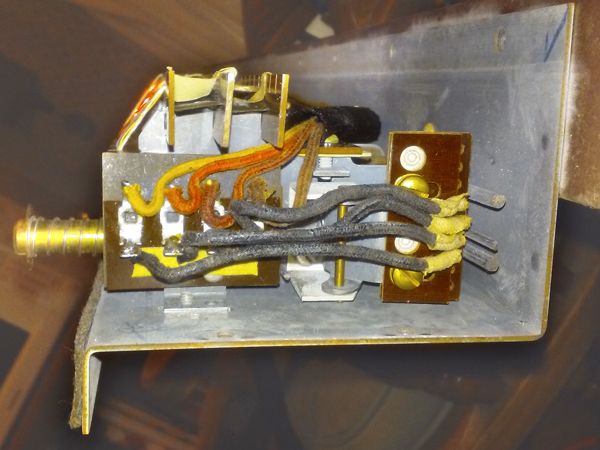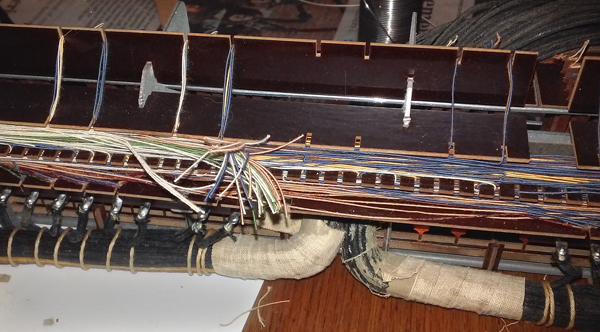String Bass Effect and MIDI on a C2
North Suburban HAMMOND ORGAN Service
Here are some more pictures of the pedal switch assembly. For many of you who own traditional Hammond organs, this may be your first ever look at what a Hammond pedals switch assembly looks like inside. As you look at the pictures, you have to be impressed at how well-made all this original Hammond stuff is. Laurens Hammond most likely felt that he had designed the ultimate and perfect musical instrument, and he could not have really seen what the future of electronic music would bring, but although he made it difficult to add any accessories to a typical hammond, he was a stickler for quality and really developed a very fine and well-made product.

Figure 2. Here's the Hammond C2 pedal busbar shifter unit. The slotted brass "screw" to the left by means of a small bell-crank arrangement will move all four pedal busbars to the right or left which gives you a new contact surface. The pedal switch assembly is upside-down in this picture, the pedal actuators are entering from what appears to be the bottom.
It's too bad that by the time the X66 came on the scene, Hammond was forced to adopt some cost-cutting measures, but you really can't go wrong getting a traditional Hammond* from Hammond's golden era when they strove to build the best and most reliable keyboard instrument of all time. This is why I, and many others feel, that rather than buy a new electronic organ, you are actually better off adding modern electronic supplements to an existing traditional Hammond. (And it's probably largely responsible for the fact that these instruments, particularly the console models, B3 C3, and even the earlier B2 and C2 hold their value.) Granted, this means of course either doing the modernizing yourself, or finding someone to do it for you, and this work is not cheap. But the end result is an instrument with modern versatility and Hammond's incredibly excellent construction.
It is of course possible to add external contacts to the underside of a typical Hammond pedalboard and indeed that is probably the way most folks would go about this task. My reasons for using the internal contacts are several. First of all, in doing this, I have permanently eliminated the four highest harmonics of the pedal tone. As found from the factory, these four harmonics are a permanent part of the sound of the upper or right pedal drawbar and they give that a somewhat "hornlike" tone. In my opinion, this sound is essentially useless for most pops playing. Second, external pedal contacts invariably will get very dirty in a fairly short amount of time. If you have a Hammond in your home and play it regularly, you will find that within a couple of month's time, the area under the pedalboard becomes really dirty. Then too, the pedalboard is primarily made of wood and as such it is subject to minute seasonal dimensional changes which really aren't noticeable as far as playing is concerned, but this could make a slight difference in contact operation.

Figure 3. Getting into the pedal resistance wire loom to remove wires from top four contacts for each pedal. This also makes the cable from the pedal switch to the tone generator a little smaller which is helpful because this then gives me extra room in the Hammond wiring tube for the string bass and MIDI cables.
After considering these three conditions, I opted for using the internal Hammond contacts inasmuch as they are sealed, very well made, accurate, and dimensionally stable. Plus, I really don't care for that hornlike tone that the upper pedal drawbar has. Because Hammond pedals have two contacts per pedal per busbar, and I needed one busbar to control string bass and one to control MIDI, using the internal contacts meant sacrificing four pedal harmonics. But that is in, my opinion a small price to pay for what I will gain. Years ago I wired in "poor man's bass" on this C2 which eliminates the top four pedal harmonics anyhow although they were available on one of the lower manual drawbars that I borrowed for the purpose. But I found as I played that I almost never used them. Since I am adding MIDI to the pedals, MIDI will give me a huge variety of different horn tones on the pedals if I should want them, and they will be much more accurate instrument imitations than the four top harmonics on the original Hammond scheme would produce.
Home Page Page2. Next page | Previous page